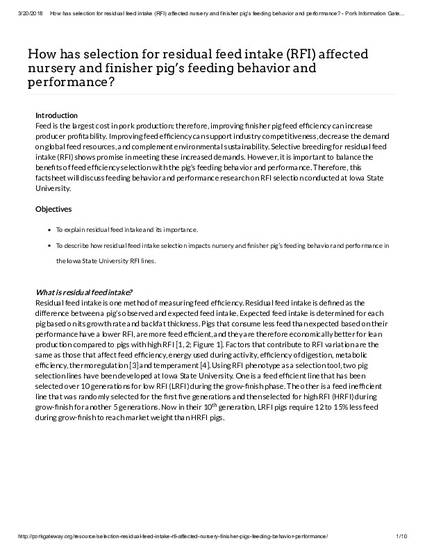
Unpublished Paper
How has selection for residual feed intake (RFI) affected nursery and finisher pig’s feeding behavior and performance?
Animal Science White Papers, Technical Reports, & Fact Sheets
Document Type
Report
Publication Date
12-21-2017
Disciplines
Abstract
Feed is the largest cost in pork production; therefore, improving finisher pig feed efficiency can increase producer profitability. Improving feed efficiency can support industry competitiveness, decrease the demand on global feed resources, and complement environmental sustainability. Selective breeding for residual feed intake (RFI) shows promise in meeting these increased demands. However, it is important to balance the benefits of feed efficiency selection with the pig’s feeding behavior and performance. Therefore, this factsheet will discuss feeding behavior and performance research on RFI selection conducted at Iowa State University.
Copyright Owner
U.S. Pork Center of Excellence
Copyright Date
2017
Language
en
File Format
application/pdf
Citation Information
Samaneh Azarpajouh, Jessica Colpoys, Jack Dekkers, Nicholas Gabler, et al.. "How has selection for residual feed intake (RFI) affected nursery and finisher pig’s feeding behavior and performance?" (2017) Available at: http://works.bepress.com/john-patience/41/

This report is published as Samaneh Azarpajouh, Jessica Colpoys, Jack Dekkers, Nicholas Gabler, Elisabeth Huff‐Lonergan, Steven Lonergan, John F. Patience, Anna K. Johnson. How has selection for residual feed intake (RFI) affected nursery and finisher pig’s feeding behavior and performance? Factsheet, Pork Information Gateway. (2017). Posted with permission.